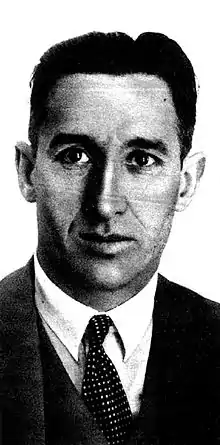Ángel Pestaña
Ángel Pestaña Nuñez (14 February 1886 in Ponferrada – 11 December 1937 in Barcelona) was a Spanish Anarcho-syndicalist and later Syndicalist leader.
Ángel Pestaña | |
|---|---|
 | |
| Secretary General of the Confederación Nacional del Trabajo | |
| In office 1929–1929 | |
| Preceded by | Juan Peiró |
| Succeeded by | Juan López |
| In office 1930 – March 1932 | |
| Preceded by | Progreso Alfarache |
| Succeeded by | Manuel Rivas |
| Secretary General of the Syndicalist Party | |
| In office 1932 – 11 December 1937 | |
| Member of the Congress of Deputies | |
| In office 28 February 1936 – 11 December 1937 | |
| Constituency | Cádiz |
| Personal details | |
| Born | Ángel Pestaña Núñez 14 February 1886 Ponferrada, León, Spain |
| Died | 11 December 1937 (aged 51) Begues, Barcelona, Spain |
| Citizenship | Spanish |
| Political party | Syndicalist Party |
| Occupation | Syndicalist, Politician |
Biography
Early life
He came from an impoverished background, being forced to earn a living from a very early age and trained as a clockmaker. He was imprisoned in Sestao, Spain, following his participation in a political rally, when he was fifteen years old.
After travels in North Africa and France, Pestaña settled in Catalonia, and became active in local anarchist politics. He took part in the Confederación Nacional del Trabajo (CNT) Congress of 1918, being unanimously elected editor-in-chief of the group's newspaper Solidaridad Obrera. Under his direction, the paper mounted a violent campaign against the local police force, accusing its leader of being a hireling of Imperial Germany.
In April 1919, after Catalonia was shaken by the Canadenca protests, Pestaña was arrested and detained, and the paper banned. He left for Bolshevist Russia in 1920, in order to be present at the 2nd Comintern Congress and the preliminary sessions of the Profintern.[1] There he met Vladimir Lenin, Leon Trotsky, Grigory Zinoviev, and other Bolshevik leaders. Upon his return, he was yet again detained.
Conflicts with the government and the anarchists
Together with his mentor Salvador Seguí,[2] Pestaña opposed the paramilitary and terrorist actions advocated and carried out by other members of the CNT. In August 1922, he was the victim of an assassination attempt while giving a speech in Manresa, as part of the violent repression measures taken by the Spanish authorities. The indignation caused throughout Spain by news of this act brought the dismissal of several government officials, as well as an end to legislation that permitted the murder of trade union activists.[3]
After Seguí fell victim to an assassination, Pestaña remained the main figure of the moderate CNT. This position allowed him to oppose, together with Joan Peiró, all attempts by the 1927-founded Federación Anarquista Ibérica (FAI) at assuming control of the CNT during the dictatorship of Miguel Primo de Rivera.
Split with the CNT
After the proclamation of the Second Spanish Republic in 1931, the conflict between Pestaña's group and FAI deepened: Pestaña initiated the issue of Manifiesto de los Treinta/Manifest dels Trenta ("Manifesto of the Thirty"), a clear condemnation of the Federación's tactics, one which got him expelled from the CNT in August.[4] He went on to found his own Syndicalist Party in the closing months of 1932.
The Party adhered to the Popular Front, and Pestaña was elected to the Cortes on a Front platform in 1936, as one of the two Party representatives (he had won a seat in Cádiz). In October, with the start of the Spanish Civil War, he was appointed general subcommisioner for War, but had to resign due to bad health in December. He died soon after, and the Syndicalist Party did not survive the end of the conflict. He is interred in the Montjuïc Cemetery in Barcelona.
Quotes
- The trade-unionists will act lawfully [only] as long as the law is respected.
Legacy
A homage to Pestaña was made on 13 February 1938 at the Fuencarral Theater in Madrid, in commemoration of his birth. The tribute was attended by speakers of the Syndicalist Party, the Communist Party of Spain, the Popular Front, the Iberian Anarchist Federation, the Republican Left and the National Confederation of Labour.[5]
A square in the Nou Barris district of Barcelona is named Ángel Pestaña in his honour.[6]
References
- Peirats, José (2011). The CNT in the Spanish Revolution, Volume I. Hastings: PM Press. ISBN 978-1-60486-207-2.
- Kaplan, Temma (1993-11-12). Red City, Blue Period: Social Movements in Picasso's Barcelona. Univ of California Press. p. 127. ISBN 9780520084407.
- Carr 2002
- Woodcock 2004, p. 322
- Homenatge a Ángel Pestaña (13 de febrer de 1938) Estelnegre.org (in Catalan)
- Urbanització de la Plaça Ángel Pestaña a Nou Barris Publicespace.org
Sources
- Carr, Raymond (2002). Modern Spain, 1875-1980. Oxford University Press. ISBN 0-19-280129-5.
- Peirats, José (2011). The CNT in the Spanish Revolution, Volume I. PM Press. ISBN 978-1-60486-207-2.
- Woodcock, George (2004). Anarchism: A History Of Libertarian Ideas And Movements. Broadview Press. ISBN 1-55111-629-4.
External links
- Ángel Pestaña Daily Bleed's Anarchist Encyclopedia